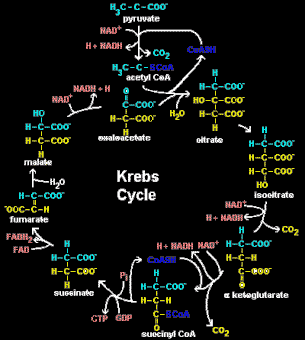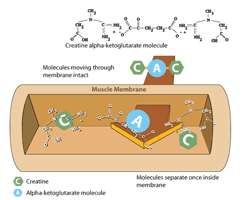The bodybuilding community has trusted creatine supplementation for over a decade now, and for good reason - it flat-out works. With that said, there's always room for improvement, especially with all the recent technological and scientific advancements being made in the supplement industry.
One of the most innovative and increasingly popular forms of creatine available today is creatine alpha-ketoglutarate (a.k.a., creatine-AKG). It has a wealth of advantages over regular creatine that any bodybuilder, powerlifter, or athlete can certainly use to help make incredible gains in muscular size and strength.
Unlocking The Mystery Of Creatine-AKG
Simply put, creatine-AKG is creatine attached to an alpha-ketoglutarate molecule. Now, creatine alone has been extensively studied over the past decade, and its musclebuilding and strength-enhancing properties are nothing short of impressive.
Nearly all hardcore bodybuilders and strength athletes are more than familiar with creatine's primary benefits. However, creatine-AKG is something quite new. A quickly growing research-based supplement company, NxCare Inc., was the first to bring creatine-AKG to the bodybuilding market with the launch of their highly popular muscle cell volumizer, ANAVOLTM.
The development of ANAVOL was an arduous process, as supplement insiders told the company that binding AKG to creatine wasn't possible. Not willing to take no for an answer, the research team moved on to work with pharmaceutical chemists outside of the supplement industry. Using an exclusive manufacturing process, they successfully bonded creatine to AKG.
Why Attach Creatine To AKG?
There is a specific reason why creatine has been bound to the AKG molecule. Since AKG is a Krebs cycle intermediate it can easily enter muscle cells, bringing with it more creatine directly into targeted cells (i.e., your muscles).

The Krebs cycle is a series of chemical reactions that take place in living cells and is involved in oxidative metabolism (energy production).1 The Krebs cycle occurs in the mitochondria of cells. And guess what? More mitochondria are found in cells that expend a significant amount of energy, like muscle cells.2 Therefore, AKG acts as a transporter of creatine to bring more creatine into the targeted muscle cells.

AKG Transporting Creatine Molecules Into Muscle Fiber.
This illustration shows how the AKG molecule helps transport two creatine molecules into the muscle fiber where they eventually split and perform their functions.
The Key Benefits Of Creatine-AKG
As already explained, creatine-AKG transports more creatine directly into muscle cells and this results in a higher muscular creatine concentration. With a higher creatine concentration in the muscle, strength and power performance is significantly enhanced.
This means more reps and heavier weights in the gym, which can quickly translate into greater muscle growth. Also, with more creatine being shuttled directly into muscle cells, more water is pulled inside cells.3
This is a benefit because it can trigger an immediate anabolic response, whereby muscle cells quickly expand due to the influx of water (cell volumization), and protein synthesis is stimulated (new muscle fiber growth) to fill up the intracellular space.4
This is a fascinating process and the key to creatine-AKG's powerful muscle-building effects. Another benefit of creatine-AKG is that it doesn't cause transporter downgrade. Regular creatine requires a creatine transporter protein (CreaT) for its uptake into muscle cells.
Some research has shown that chronic supplementation with regular creatine can cause creatine transporter downgrade. This means creatine cannot efficiently be taken up by the muscle cell. However, since creatine-AKG uses AKG as a transporter, creatine transporter downgrade is a non-issue.
Surely you know someone who has classified themselves as a "creatine non-responder," or perhaps you even have yourself. The fact is, you won't experience the incredible effects of creatine unless your muscular creatine concentrations reach optimal levels.
This is why creatine-AKG is such a great option for so-called "creatine non-responders." It maximizes creatine concentration in the muscle by taking advantage of AKG as a transporter of creatine.
The Final Word On Creatine-AKG
With all the scientific support behind a compound like creatine it's no wonder it has become a staple in the supplement regimen of most bodybuilders and power athletes. Now, by means of the most recent technological advancements, the creation of creatine-AKG has lifted the effectiveness of creatine to all new heights.
With its ability to easily enter muscle cells, maximize muscular creatine concentrations and trigger a significant anabolic response, creatine-AKG, which can be found in ANAVOL, is now leading the way in creatine technology. The result—helping bodybuilders and power athletes smash through training plateaus and maximize genetic potential.
References:
- "Krebs cycle." (2003). The Columbia Electronic Encyclopedia, Sixth Edition. Columbia University Press. Retrieved Aug. 10, 2005.
- Campbell, N.A. (1990). Biology, Second Edition. Redwood City, CA: The Benjamin/Cummings Publishing Company, Inc.
- Volek J.S. and Rawson, E.S. (2004). Nutrition. Jul-Aug;20(7-8):609-14.
- Ritz P, et al. (2003). Eur J Clin Nutr. 2003 Dec;57 Suppl 2:S2-5.


